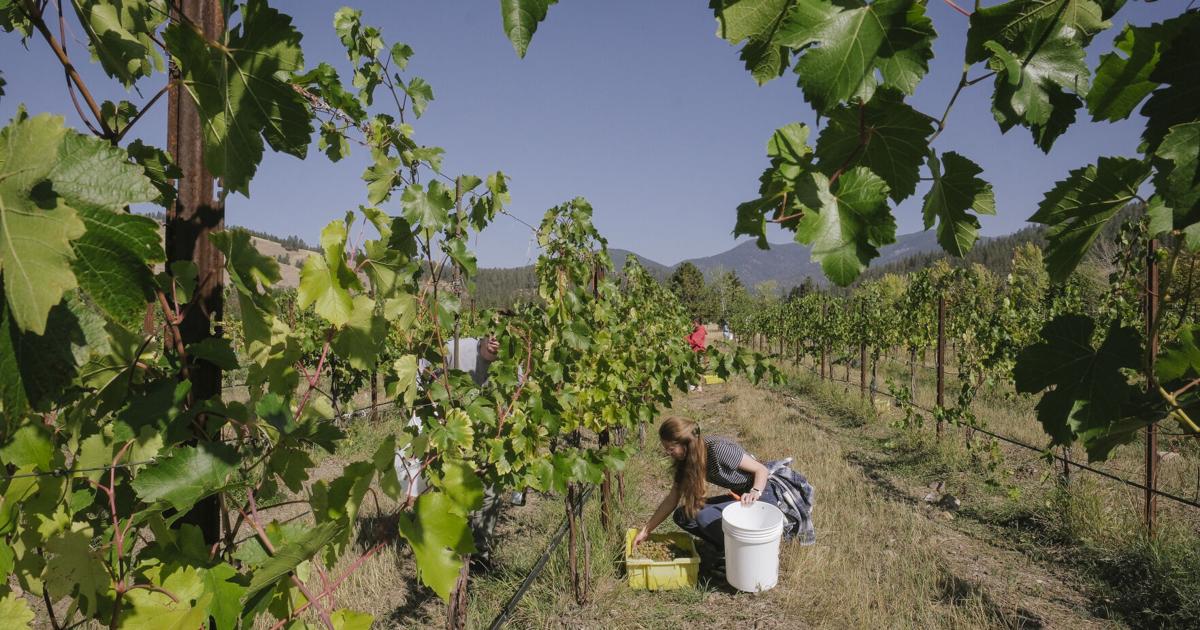
It’s grape harvest season at the Ten Spoon Vineyard and Winery in Missoula, which is the largest commercial winery that uses its own grapes in Montana.
Every fall, owners Andy Sponseller and Connie Poten host a Community Grape Harvest, where they enlist volunteers to head out into the vineyards with scissors or clippers to help haul in the fruit in exchange for a nice picnic lunch and beverages. It’s pretty relaxing work, dropping grapes in a bucket, and there’s no time requirement.
They’ve got almost 8 acres in production. Right now, they’re harvesting the St. Pepin, which will make a white wine.
“They’re such good grapes,” Sponseller said, cutting a bunch off a vine. “It’s easily all-around the best grape I have in the vineyard. It’s very, very disease-resistant, it’s late-flowering and early-ripening. That’s really good in this country. It misses the frost on either end.”
Climate change is tough on agricultural producers all over the world, as it throws once-predictable weather patterns into disarray. It’s no different for grape growers.
“The weather’s changed so dramatically, it’s like the difference between day and night between 10 years ago and now,” Sponseller explained. “I can’t see where there’s gonna be a frost anytime soon, but a lot of times we were sweatin’ frost right now.”
In years past, they had to hire a helicopter in the spring and fall to keep cold air off the vines.
“But it seems like in terms of climate change, we’ve moved beyond that,” he said. “I mean, we’re actually now starting to get vines that are done doing their thing before we get a frost. Used to be, we were sweatin’ about whether we’d get through the ripening cycle by (the time) a killing frost happened or not. That’s not the case anymore.”
He has the grapes examined in a lab to make sure the sugar content is high enough before they’re harvested.
A deep freeze in mid-October of 2020 killed the buds, so he’s had to work hard to repair the vines.
“This is all recovery stuff from 2020, because this whole vineyard got frozen down the the ground,” he said. “And so we’ve been rebuilding the vineyard ever since. It’s just such a slow process up here, because in this country the growing season’s not as long. But I have to say, that even the wood’s growing better now that it used to because we have so much more heat content.”
Due to climate change, the vineyard is getting more “total heat accumulation” than it used to, something that’s also referred to as “degree days” in the industry.
In 2013, the Missoulian reported on a study titled “Climate Change, Wine and Conservation” that was published in the Proceedings of the National Academy of Sciences. The authors predicted that places like Montana could see a big boost in grape-growing potential due to climate change, while established wine regions like California could lose suitable territory due to too much heat.
But big producers in California, Oregon and Washington have so far not invested too heavily in growing in Montana, because Ten Spoon is still the largest operation in the state, producing about 12,000 bottles a year.
“It’s all about the highs and lows (in temperature),” Sponseller said. “And spikes. The spikes are what get you. And that’s what got us (in 2020). And so whether or not (climate change) really facilitates a burgeoning, growing area or not, I don’t know. You can quote me on this: The jury’s not in on whether this is the next growing area or not.”
But, he said, things are “pointing in the right direction” for people to be able to grow certain varieties.
“The problem is doing it successfully, on a commercial level,” he said. “We’ve been doing it just by force of will the last 20 years or so. It’s been longer than that actually. The first thing people think about when temperatures get warmer in a place is ‘oh wow, now we can grow pinot noir and cabernet sauvignon and chardonnay and blah blah blah’ and the truth of the matter is, they’re all Mediterranean-style grapes.”
And those types, he said, are a long way from being viable for Montana growers.
The entire Ten Spoon Winery, on 21.5 acres in the Rattlesnake, is for sale for $5.39 million.
“I don’t think people realize that Connie and I have been doing this for a long time,” Sponseller said, when asked why it’s been listed for sale.
They’ve added events, like live music and dance performances, to help boost their bottom line.
“The future of small family wineries like this is in successful on-property sales,” he said.
Poten said the only reason they held their “community harvest” this week on Thursday and Friday was because they have performances by Bare Bait Dance on Saturday and Sunday, Sept. 20-21.
“We should be harvesting red grapes in two or three weeks,” she said.
For more information and updates on the harvest days visit online at TenSpoon.com.
David Erickson is the business reporter for the Missoulian.
You must be logged in to react.
Click any reaction to login.
Love
0
Funny
0
Wow
0
Sad
0
Angry
0
The business news you need
Get the latest local business news delivered FREE to your inbox weekly.
* I understand and agree that registration on or use of this site constitutes agreement to its user agreement and privacy policy.
David Erickson
Business Reporter
Get email notifications on {{subject}} daily!
Your notification has been saved.
There was a problem saving your notification.
{{description}}
Email notifications are only sent once a day, and only if there are new matching items.
Followed notifications
Please log in to use this feature
Log In
Don’t have an account? Sign Up Today



